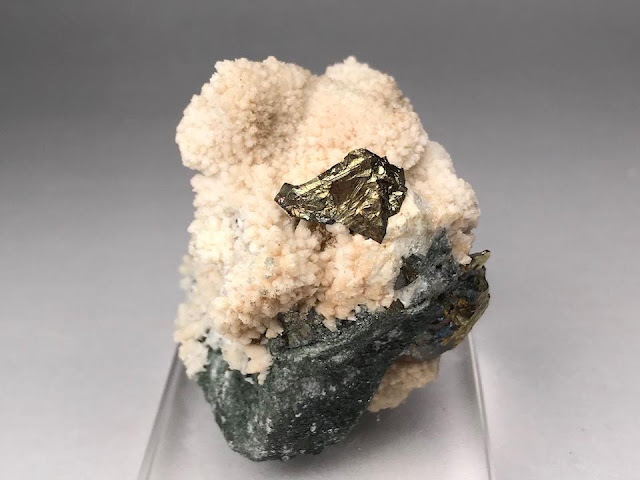阿仁の黄銅鉱と方解石 Chalcopyrite & Calcite
秋田県北秋田市阿仁萱草 佐山鉱山
Sayama Mine, Ani Kayakusa, Kita-Akita City, Akita, Japan
標本幅 width 45 - 55 mm / 重さ weight 100 g
もうひとつの標本と同じ大山ヒの産出。けっこう大きい黄銅鉱の結晶の集合を覆うように、方解石の細かい結晶がカリフラワーのようにくっつき、さらにその上に小さな黄銅鉱がぽつんとのっている。大きいほうの黄銅鉱には、方解石がびっしりくっつく面と、そうでない面とがあるようで、後者のほうは、やや変質しつつも、にぶい光を放っている。方解石は母岩(緑色凝灰岩か)にも部分的に着生している。「どうしてこうなった?」と思わずにはいられない。
From Oyama vein like another sample. A small chalcopyrite sits on white cauliflower-like fine calcite crystals coating a fairly large chalcopyrite conglomerate. The larger one has two types of crystal surfaces on which calcites are scattered and not. The surface that repels calcite gives out a dull shine. Calcite also grows on a piece of the (green tuff) bedrock in part. I can't help thinking why it turns out like this.
佐山鉱山はなんといっても閃亜鉛鉱の巨大結晶が有名である。秋田県鉱山誌(秋田県鉱山会館、2005)によると、閉山直前の1967年には、金が月産 39 kg、銀が 3 kg(金と銀は数値が逆?)、銅が 1 トン、というから、この時代まだ日本各地に点在した小規模鉱山のひとつだった、といえる。ただその割には、佐山産の標本はけっこうたくさん出回っているようにおもう。寺島靖夫「探検!日本の鉱物」(ポプラ社、2014)によると、佐山鉱山の鉱脈は晶洞が多く、閉山後も標本用に操業したそうだ。
It is huge sphalerite crystals that make Sayama mine famous though it was a small mine. In 1967 just before the closure, Sayama produced 39 kg of gold, 3 kg silver (the numbers are reversed?) and 1 ton of copper per month (Akita-Ken Kozan-Shi, Overview of Mines in Akita Prefecture, 2005).
参考: 国立科学博物館所蔵の佐山鉱山産閃亜鉛鉱 Sayama specimen of sphalerite in National Museum of Nature and Science


